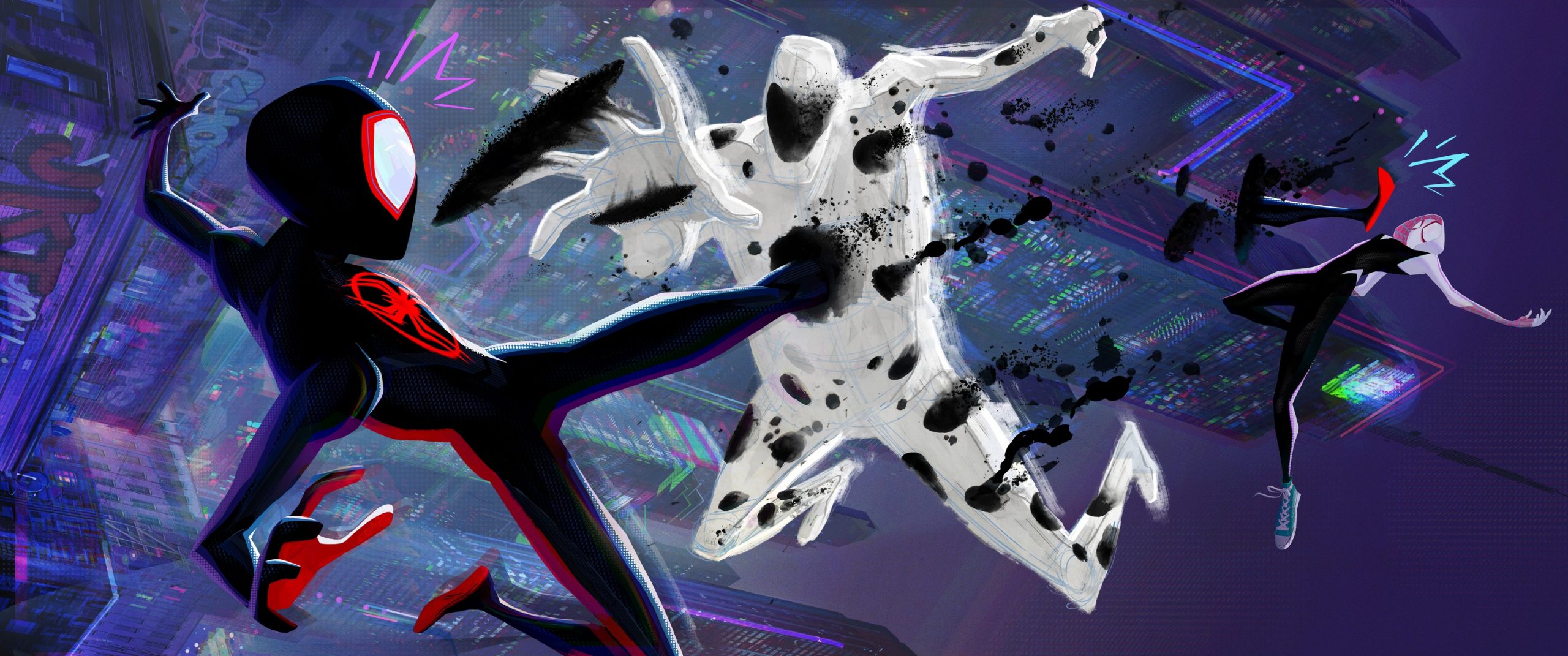
Film Editor Jess Parker praises Spider-Man: Across the Spider-Verse’s ability to stand out amongst the growing over-saturation of Superhero movies
Spider-Man: Across the Spider-Verse, the sequel to the phenomenally successful Spider-Man: Into the Spider-Verse (2018) released to UK cinemas on the first of June 2023 and is directed by Joaquim Dos Santos, Kemp Powers, Justin K. Thompson. The film is expected to be the second installment of a trilogy, with the third movie expected to be entitled Spider-Man: Beyond the Spider-Verse. It feels common for the second entry in beloved trilogies to often fall flat in comparison to their opening and closing companions; however, Spider-Man: Across the Spider-Verse subverts this expectation by entirely living up to its predecessor.
The film takes place a few years after Spider-Man: Into the Spider-Verse, following Miles Morales (Shameik Moore) and Gwen Stacy (Hailee Steinfeld) as they come to terms with their lives isolated in different universes. When Gwen is faced with the choice of crossing the boundaries of the multiverse, she accepts, catalysing the plot’s introduction to the full extent of the Spider-Verse. As Miles and Gwen’s stories collide once again whilst pitted against their new Supervillain, Spot (Jason Schwartzman), Miles has to face what matters to him most as he comprehends the true gravity of his superhero persona.
“Perhaps the most impressive and memorable is that of Spider-Punk (Daniel Kaluuya), an anarchic variant whose rebellious personality is represented by his Punk visual art-style animation
As was the case with Spider-Man: Into the Spider-Verse, the artistic styles employed throughout Spider-Man: Across the Spider-Verse’s animation is the film’s strongest asset. Multiverse-based narratives are often messy and hard to follow; however, Spider-Man: Across the Spider-Verse eradicates any room for confusion concerning its Spider-Man variants by providing them with individual art styles that suit their own stories. Perhaps the most impressive and memorable is that of Spider-Punk (Daniel Kaluuya), an anarchic variant whose rebellious personality is represented by his Punk visual art-style animation. Spider-Man: Into the Spider-Verse animated its characters in twos, meaning that a new pose was animated every two frames to showcase Miles as clunky and juvenile in comparison to the other, more well-practiced Spider-People around him. This pioneering technique is developed through Spider-Punk, who is animated on threes, pinpointing his tendency to go against the grain of those around him. He chooses to not conform to even the standard visual rhythms of the movie.

Spider-Man: Across the Spider-Verse’s pacing is well suited to the chaotic, non-stop action that the film presents. The film acts as part one of an entire narrative arc. However, it spares no expense in fitting in as many well-rounded subplots, explanations, and character profiles as possible in its runtime of two hours and 16 minutes. Although finishing on a cliffhanger, there do not feel to be any loose threads or moments that feel underdeveloped. The film is not too long at all but instead, makes the most of its runtime by setting up a highly anticipated finale for a globally beloved series of movies.
“Currently, Spider-Man feels like the only Marvel franchise that has the capabilities to tackle the Multiverse appropriately.
In the current climate of Superhero movies, and of course, Marvel in particular, the Multiverse feels like a sore subject. Most of Marvel’s current exploits, whether that be in film or television, feel over-saturated with stories concerning alternate universes and variants of our favourite characters: think Loki (2021), Doctor Strange in the Multiverse of Madness (2022), Ant-Man and The Wasp: Quantum Mania (2023), and even Spider-Man: No Way Home (2021). Unlike the vast majority of these aforementioned titles, Spider-Man: Across the Spider-Verse does not feel like it is rehashing the same story over and over again for the sake of the Disney machine’s habit of bleeding franchises dry of any sense of fan anticipation. Although still centred around the concept of the Multiverse, the film takes a unique and specific angle that removes itself from this current trend of blatantly retelling the same story with a different cast. Currently, Spider-Man feels like the only Marvel franchise that has the capabilities to tackle the Multiverse appropriately.
Verdict
It is films like these that give me hope for the future of Marvel, and honestly, individuality in cinema. Spider-Man: Across the Spider-Verse builds upon the foundations set by its predecessor and surpasses them, developing into a grippingly thrilling and shockingly beautiful couple of hours. It is a stunning experience that leaves you desperate for a conclusion, yet with the promise that audiences will eventually receive one. If the past two installments are anything to go by, audiences should already be marking March 2024 out in their calendars for the arrival of Spider-Man: Beyond the Spider-Verse.
10/10
Spider-Man: Across the Spider-Verse is in cinemas now.
For more on recent cinematic releases, check out these reviews from Redbrick Film:

Comments